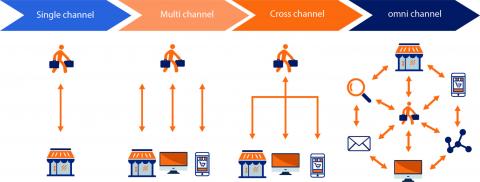
Masterclass e-commerce
A good e-commerce franchise strategy has several dimensions. Primarily, it must add value to the consumer's shopping experience. This is always the priority; otherwise, there is no justification for its existence. Additionally, it must be commercially viable, either generating additional gross margin or saving costs. If this is not the case, then the investments made in e-commerce are purely marketing expenses, and the focus should be primarily on brand awareness, brand perception, and market share. It is also crucial to realize that e-commerce in franchise organizations must be commercially beneficial for both the franchisor and the franchisees to achieve optimal integration of channels.
What types of e-commerce are there?
Consumers are increasingly getting used to a blending of channels that reinforce each other. If there is no e-commerce involved, we call this a 'single-channel.' A 'multi-channel' strategy, the next step, involves serving consumers through multiple sales channels. Consumers can choose to buy a product online or in-store. Online and the store are not coordinated here, which can lead to, for example, different prices and separate customer service. Because the various channels coexist, it is challenging to compete with other e-commerce organizations. The channels must actively reinforce each other to provide the optimal experience for customers in the long run. 'Cross-channel' goes a step further than multichannel. The consumer is served in a uniform way through multiple channels and has the option to order items online and pick them up in a physical store. The customer service is also aware of this. In short, all sales channels are organized 'intermixed.' With 'omni-channel,' the aim is to minimize friction in the buying process (the customer journey). In omni-channel, consumers use channels interchangeably while ensuring the experience, prices, and information are the same everywhere. All channels seamlessly integrate with each other, creating a fully transparent process.
When is e-commerce effective?
Implementing, maintaining, or further developing an e-commerce franchise strategy is incredibly complex. There are three parties that benefit from the webshop, namely the franchisor, the franchisees, and the customers. It is crucial to make clear agreements on this. However, it is important to first structure the e-commerce franchise strategy so that it is effective for all parties.
- To minimize friction, we recommend offering as many payment options as possible.
- The flexibility in ordering should ideally also be reflected in the return process. Customers should be able to return a product that does not meet expectations via any channel, regardless of the channel where it was purchased. This means they can return it in any store or by mail.
- A good omni-channel strategy offers numerous opportunities to improve the customer experience and achieve channel synergy. By brainstorming and implementing innovations early in the formula, using omni-channel can not only follow trends but also set trends. In the case of a store that complements the webshop, it makes sense to work toward 'experience centers' that mainly further the brand instead of being primarily a retail channel.
- To build a good customer database, it is important that building and utilizing the customer database holds value for every group (franchisor, franchisee, but also the customer). It is crucial to realize that every channel has its advantages and disadvantages, which can be addressed optimally. In a physical store, a customer can receive personal attention and try products directly. Online, these opportunities are not available, but the customer is not restricted by opening hours or a limited collection. They also don't have to leave the house. Ultimately, the customer chooses what is most important to them at that moment, and a good revenue model is possible for every channel. Here, the channels should reinforce each other to such an extent that the total turnover is greater than what the channels could achieve separately. This way, both online and stores retain their potential in the long term.
Masterclass e-commerce, become a master in franchising!
As mentioned earlier, implementing, maintaining, or further developing the e-commerce franchise strategy can bring about a lot of friction. Which e-commerce franchise strategy should be chosen, for instance? Are we doing everything correctly to have an optimal e-commerce franchise strategy in place? How can we ensure that all franchisees join in and actively want to contribute to the e-commerce franchise strategy? Koelewijn & Partners has all the expertise necessary to assist you with these issues through our Masterclass e-commerce.